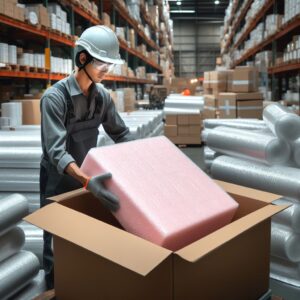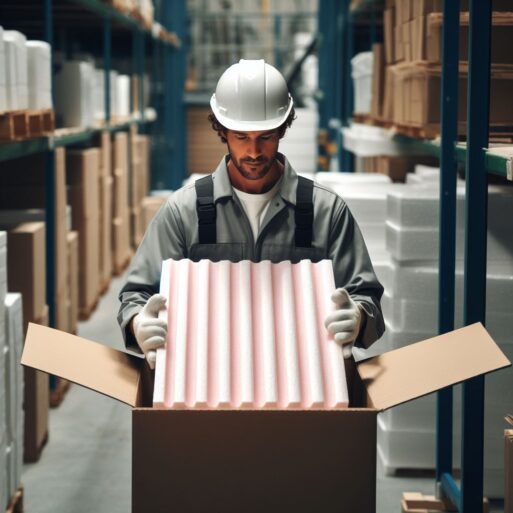In the world of shipping, packaging plays a pivotal role in ensuring your precious cargo arrives intact. While there are various packaging materials to choose from, foam packaging stands out for its excellent protective qualities. In this guide, we’ll delve into the world of foam packaging, exploring the types available, considerations for selection, benefits, and best practices. Whether you’re shipping fragile electronics, delicate glassware, or any other valuable items, this guide will help you make the right choice while choosing packaging foam.
Types of Packaging Foam:
When it comes to foam packaging, you have several options at your disposal, each with its unique characteristics and applications:
- Polyethylene Foam: This type of foam is known for its lightweight yet durable nature. It’s an ideal choice for cushioning and protecting items during transit. Polyethylene foam is versatile and can be used for a wide range of products, from fragile electronics to delicate glassware. Its lightweight properties help reduce shipping costs, while its durability ensures that your items are well-protected.
- Polyurethane Foam: Polyurethane foam is highly versatile and well-suited for custom cushioning solutions. It provides excellent shock absorption, making it perfect for delicate and valuable items. Mold it to fit the shape of your products, providing a tailored and snug fit. Many use this foam type for sensitive electronics, artwork, and precision instruments.
- Polystyrene Foam: Polystyrene foam is commonly used for insulation, but it’s also an effective choice for keeping temperature-sensitive items safe during shipping. It offers thermal insulation properties, which help protect items from extreme temperature fluctuations. This makes it an excellent choice for shipping perishable goods, pharmaceuticals, and items that require temperature stability.
Pros and Cons Of Different Types of Packaging Foam:
Each type of foam has its unique advantages and drawbacks, so let’s explore when to use each for optimal protection:
- Polyethylene Foam:
- Pros: Lightweight, durable, cost-effective, versatile, and recyclable.
- Cons: Less effective for extreme temperature conditions.
- Polyurethane Foam:
- Pros: Excellent shock absorption, customizable, ideal for delicate items.
- Cons: Slightly higher cost, less eco-friendly compared to some other foam types.
- Polystyrene Foam:
- Pros: Great for temperature-sensitive items, cost-effective.
- Cons: Less cushioning compared to other foams, not as environmentally friendly.
Considerations for Choosing Packaging Foam:
Selecting the right foam packaging requires careful consideration of various factors:
- Item Characteristics: Take into account the weight and fragility of the item being shipped. Heavier or more delicate items may require specific foam types. For instance, use polyurethane foam for valuable glassware and polyethylene foam for lightweight electronics.
- Environmental Factors: Consider temperature and environmental conditions during transit. Some foam materials, like polystyrene, are better suited for extreme temperature conditions, ensuring your items remain safe from temperature-related damage.
- Compatibility: Ensure your foam packaging materials work well with other packing materials, such as boxes, tape, and labels. It’s essential that your packaging components work together seamlessly for the best protection.
- Budget: While budget constraints are a consideration, remember that investing in quality foam can prevent costly damage to your items. It’s an investment that pays off by reducing the risk of returns and damage claims.
- Customization: Explore the customization options available for a tailored solution. Custom foam packaging can be designed to precisely fit your products, offering the utmost protection during transit.

Benefits of Foam Packaging:
Why choose foam packaging?
- Protection: Foam packaging offers exceptional protection, reducing the risk of damage during transit. It acts as a cushion that absorbs shock and impact, ensuring your items arrive in pristine condition.
- Cost-Effective: Despite the initial investment, the cost-effectiveness of foam packaging becomes evident when it prevents damages and returns. You save money on replacements and build a reputation for delivering intact products.
- Eco-Friendly: Many foam materials are recyclable, contributing to sustainability efforts. By choosing recyclable foam packaging, you reduce environmental impact and demonstrate your commitment to eco-friendly practices.
Tips and Best Practices for Choosing Packaging Foam:
For the best results with foam packaging:
- Proper Wrapping: Learn how to wrap and secure items using foam packaging effectively. Wrap the foam tightly around your products to ensure maximum protection during transit.
- Optimal Usage: Use the right amount of foam based on the items being shipped. Avoid over-packing, which can increase shipping costs, while ensuring that there’s enough cushioning for adequate protection.
- Storage: Store foam packaging materials appropriately to extend their lifespan. Keep them in a cool, dry place to prevent deterioration and maintain their protective properties.
- Common Challenges: Address common packaging challenges and how foam packaging can help overcome them. Whether it’s reducing breakage or protecting temperature-sensitive items, foam packaging can solve various shipping problems.
By understanding the types of foam packaging, the considerations for choosing the right foam, the benefits it offers, and the best practices for usage, you can make informed decisions to protect your valuable items during shipping. Blue Rose Packaging is here to provide you with the right foam packaging solutions to meet your unique needs.
Frequently Asked Questions (FAQs)
Q. How do I order custom foam packaging solutions from Blue Rose Packaging?
A. Ordering custom foam packaging is easy. Simply visit our website and contact our customer support team. They will guide you through the process and help you choose the right foam packaging for your needs.
Q. Can I use foam packaging for DIY projects at home?
A. Absolutely! You can use foam packaging for various DIY projects, from cushioning artwork to creating protective padding for delicate collectibles because it is versatile.
Q. Is foam packaging environmentally friendly?
A. Many foam materials are recyclable and environmentally friendly. We also offer eco-friendly options, so you can choose the best fit for your needs and values.
Conclusion
In conclusion, choosing the right foam packaging is a crucial step in safeguarding your items during transit. Blue Rose Packaging we also offers a Custom Protective Packaging to meet your specific needs. Whether you’re shipping fragile electronics, valuable artwork, or delicate glassware, our foam packaging options provide the protection and peace of mind you need.
Additional Resources
For more information, visit our website. Explore it for related blog posts and reach out to our dedicated team for personalized assistance with your foam packaging requirements. Your valuable cargo deserves the best protection, and Blue Rose Packaging is here to help.
Beta feature

